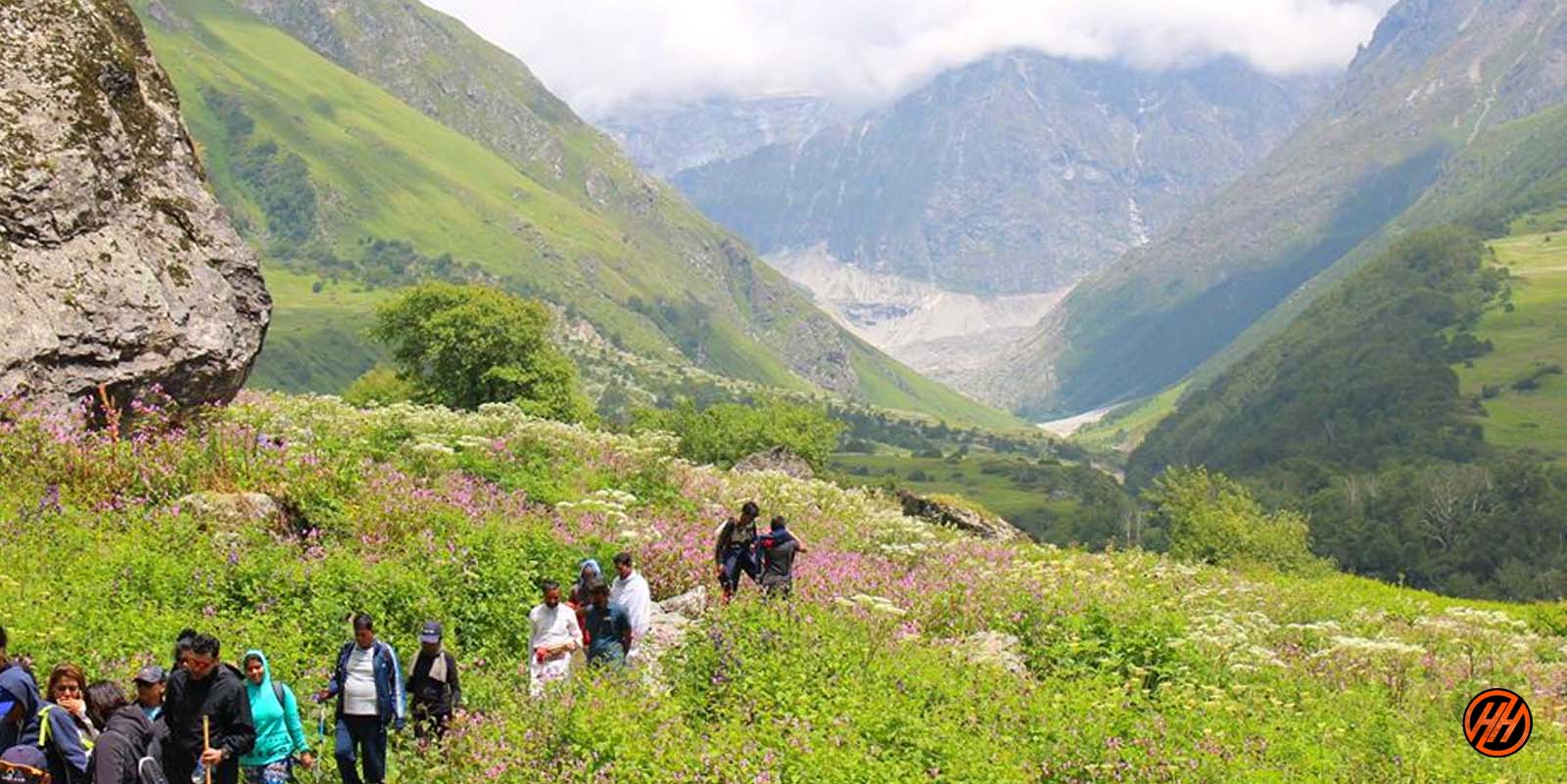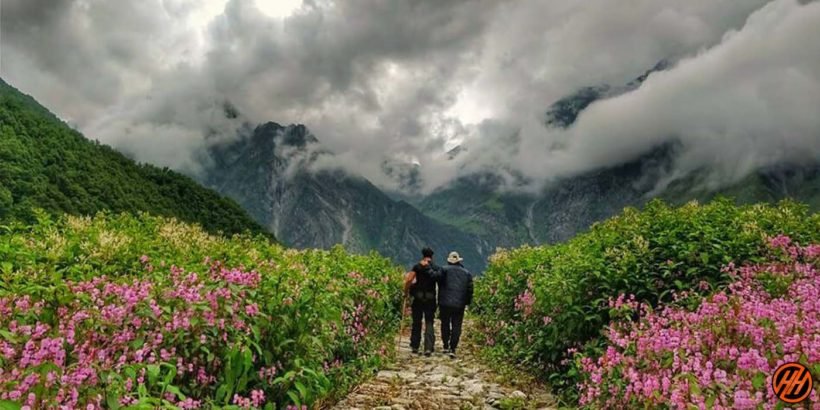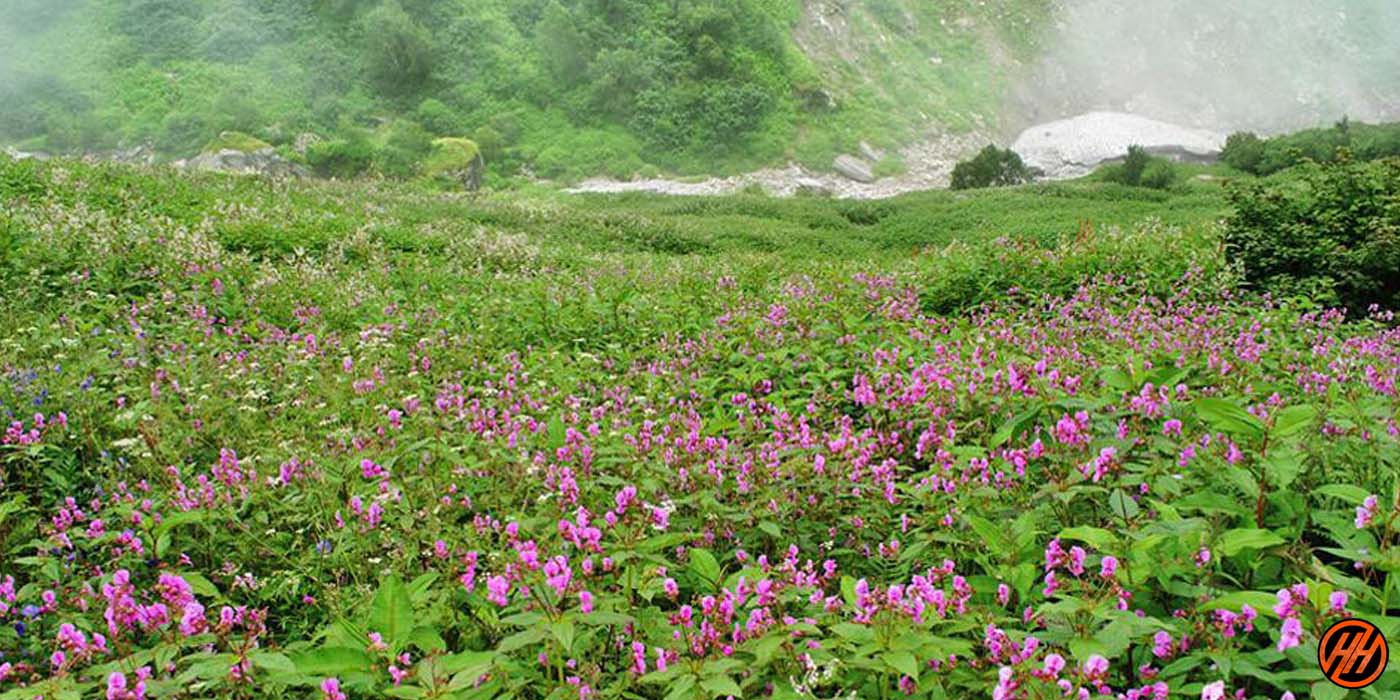
Valley of Flowers – The National Park of Flowers in Western Himalayas, Uttarakhand
Valley of Flowers National Park – Best Budget-Friendly Himalayan Trek in India
Valley of Flower is an Indian National Park, located in Chamoli district, in the state of Uttarakhand and the Valley of Flower discovered by British Mountaineer, Frank Smythe, In 1931. It is declared as a national park in 1980 and in 1982, the park renamed as Nanda Devi National Park and now it is a World Heritage Site. The Valley of Flowers National Park is one of India’s most affordable and awe-inspiring treks. Surrounded by snow-capped Himalayan peaks and blooming with over 600 varieties of exotic flowers, this UNESCO World Heritage Site is a dream for nature lovers, botanists, birdwatchers, and trekkers alike.
The Valley of Flowers extends over a region of 87.50 sq km- a territory. Smythe authored a book called The “valley of Flowers. It is in the middle of the Nar-Var and Gandhi -Maidan Mountains.
A Hidden Paradise Unveiled in 1931
The credit for discovering the Valley of Flowers goes to British mountaineer Frank Smythe, who stumbled upon this floral wonderland in 1931 while returning from an expedition to Mount Kamet. Enchanted by the colorful meadow spread across the valley, he later penned a book titled “The Valley of Flowers,” which brought this hidden gem to global attention. In 1980, the Indian government declared it a national park, and in 1982, it was included as part of the larger Nanda Devi Biosphere Reserve. Today, it is proudly listed among the UNESCO World Heritage Sites in India.
Frank Frank Smythe carried 250 seeds of different flower species with him, and he exposed that there are more than 2,500 species of flowers. Due to the flow of the Pushpawati river, it is also called Pushpawati National Park. The reason behind the growth of different species of flowers in this area due to the Fertility of Soil.

Himalayan Hikers is a tour organizer that offers Trekking and tour packages to the Valley of Flowers for 28 years.
Read About – What we do during an emergency breakout in the Trekking?
Why Valley of Flowers is a Budget-Friendly Trek
If you’re a traveler with a limited budget, this trek won’t burn a hole in your pocket. Unlike high-altitude or remote expeditions, this one can be done under ₹9,000 if planned smartly. Tour operators like Himalayan Hikers offer affordable and all-inclusive trek packages covering food, stay, guide, and permits.
Key Budget Highlights:
-
No expensive equipment required
-
No technical climbing involved
-
Homestay and guest house options available in Ghangaria
-
Government-run GMVN guesthouses offer cheaper stays
-
No need for porters or high-end gear
Explore The Beauty Of Nature at Valley Of Flowers
Mr. Bhagat Singh Rawat founder and Co-Founder Mr. Chain Singh is the prime inspiration behind establishing Himalayan Hikers.
His love for the Trekking and interest to explore the splendor of nature has translated into his company Himalayan Hikers. They have a passion for connecting with people and letting them explore the trekking place.
They believe that Trekking is not only to roam around; Trekking means to explore the world. You should get knowledge about flora and fauna. You should have a passion for exploring the World.
The scent of flowers attracts everyone and the environment is pollution-free, and People travel from abroad to enjoy the trek. ’We all know that flower is a beautiful creation of nature, flowers like the Brahma-kamal, roses, lotuses, are famous for their beauty and glamour.
Flowers’ importance in nature is everywhere- they provide natural medicine for humans’’. There is often dense fog and rain, especially during the late summer monsoon.
Read about – Trekking in India To 5 Top Himalayan Villages.
A Natural Wonderland: Flora and Fauna
The Valley spans around 87.5 sq. km and lies between the Nar-Var and Gandhi Maidan ranges. The valley comes alive from June to September, with a kaleidoscope of flowers like Blue Poppy, Brahma Kamal, Anemones, Daisies, Orchids, and Marigolds. Over 500 rare medicinal and alpine plants thrive here thanks to the fertile soil and the flowing Pushpawati River, which earned it the name Pushpawati National Park among locals.
Famous Flower Species Found Here:
-
Brahma Kamal (Saussurea obvallata) – Uttarakhand’s state flower
-
Blue Poppy (Meconopsis aculeata)
-
Primula denticulata
-
Aconitum balfourii
-
Geranium wallichianum
-
Pedicularis punctata
-
Anemone vitifolia
-
Campanula latifolia
-
Saussurea costus
These flowers bloom at different intervals during the monsoon, painting the valley in changing shades every few days.

Flower mostly AQUILEGIA PUBIFLORA, ASTER ALBESCENS, ARUNCUS DIOICUS, BISTORTA AFFINIS, etc. cover parts of the park’s area.
Those trekkers who come here for trekking carried beautiful memories with them. The villagers of Uttarakhand’s give great respect to the trekkers, that is why Uttarakhand is Known as Devbhoomi.
NOTE -: Himalayan Hikers provides all the facilities for Trekkers.
Read about – Best Budget Friendly Treks In India, Under 4000
Rare Birds Spotted in the Valley
The Valley of Flowers is also a haven for bird watchers. Some unique bird species you can spot include:
-
Himalayan Monal – National bird of Uttarakhand
-
Verditer Flycatcher
-
Slaty-headed Parakeet
-
Pink-browed Rosefinch
-
Great Barbet
-
White-capped Redstart
-
Yellow-rumped Honeyguide (Near Threatened)
This biodiversity hotspot is part of the Western Himalayas Endemic Bird Area, making it a favorite destination for wildlife photographers and ornithologists
Species of Flowers found In Valley Of flower

ACONITUM BALFOURII (Ranunculaceae , The buttercup family)
ACONITUM VIOLACEUM (The buttercup family)
BLUE POPPY (Poppy family)
CORYDALIS CASHMERIANA (Fumariaceae , Fumitory family)
CICERBITA MACRORHIZA (Asteraceae )
GAULTHERIA TRICHOPHYLLA (Ericaceae)
CYANANTHUS LOBATUS (Campanulaceae , Bellflower Family)
CYANATUS MICROPHYLLUS (Campanulaceae ,Bellflower Family)
CAMPANULA LATIFOLIA (Campanulaceae)
CAMPANULA PALLIDA (Campanulaceae, Bellflower Family)
ASTER DIPLOSTEPHIOIDES (Asteraceae)
ERIGERON MULTIRADIATUS (Asteraceae, Sunflower Family)
ERIGERON BELLIDIOIDES (Asteraceae , Sunflower Family
ERITRICHIUM CANUM ( Boraginaceae )
GENTIANA PEDICELLATA (Gentianaceae , Gentian Family )
GENTIANA PHYLLOCALYX (Gentianaceae)
GERANIUM WALLICHIANUM (Geraniaceae)
IPOMOEA PURPUREA (Convolvulaceae , Morning Glory Family)
IRIS CREMONENSIS (Iridaceae, iris Family)
NEPETA LAEVIGATA (Lamiaceae)
OXYTROPIS LAPPONICA (Fabaceae)
POLEMONIUM CAERULEUM (Polemoniaceae (phlox family)
PRIMULA DENTICULATA (Primulaceae)
PRIMULA MACROPHYLLA (Primulaceae)
SAUSSUREA PIPTATHERUM (Asteraceae)
ROSA MACROPHYLLA (Rosaceae, rose family)
POLYGONUM AMPLEXICAULE ( Polygonaceae)
PEDICULARIS PUNCTATA (Scrophulariaceae)
VIOLA PILOSA (Violaceae)
AINSLIAEA APTERA (Asteraceae)
ALLIUM HUMILE (Liliaceae)
ANAPHALIS ROYLEANA (Asteraceae Sunflower Family)
ANEMONE TETRASEPALA (Ranunculaceae)
ANEMONE VITIFOLIA (Ranunculaceae)
COTONEASTER MICROPHYLLUS (Rosaceae )
HALENIA ELLIPTICA (Gentianaceae)
CUSCUTA REFLEXA (Cuscutaceae, Dodder Family)
DIPSACUS INERMIS (Caprifoliaceae)
JUNCUS THOMSONII (Juncaceae, Rush Family)
LEONTOPODIUM BRACHYACTIS (Asteraceae ,Sunflower family)
MAIANTHEMUM PURPUREUM (Asparagaceae)
ORIGANUM VULGARE (Lamiaceae)
PARNASSIA NUBICOLA (Parnassiaceae)
POLYGONUM POLYSTACHYUM (Polygonaceae)
PRENANTHES BRUNONIANA (Asteraceae)
PRIMULA MACROPHYLLA (variety-Moorcroftiana)
PRIMULA REIDII (Primulaceae)
PRUNUS CORNUTA (Rosaceae , Rose family)
SAUSSUREA GOSSYPIPHORA (Asteraceae)
SAUSSUREA SIMPSONIANA (Asteraceae)
SAXIFRAGA CERNUA (Saxifragaceae)
SELINUM WALLICHIANUM (Apiaceae)
SPIRAEA CANESCENS (Spiraea Linnaeus)
STELLARIA SEMIVESTITA (Caryophyllaceae, pink or carnation family)
SORBARIA TOMENTOSA (Rosaceae, Rose Family)
TRICHOSANTHES TRICUSPIDATA (Cucurbitaceae)
ARISAEMA TORTUOSUM (Araceae)
ARISAEMA JACQUEMONTII (Araceae)
ARISAEMA PROPINQUUM (Araceae , Arum family)
ACONOGONUM YUCCIFOLIUM (Polygonaceae)
BRAHMA KAMAL (SAUSSUREA OBVALLATA) (Asteraceae (Sunflower family)
CODONOPSIS ROTUNDIFOLIA (Campanulaceae , Bell flower family)
CLEMATIS MONTANA (Ranunculaceae)
EUPHORBIA PILOSA (Euphorbiaceae , Castor family)
FRITILLARIA ROYLEI (Liliaceae , Lily family)
HERACLEUM CANDICANS (Apiaceae)
PHYTOLACCA ACINOSA (Phytolaccaceae)
POLYGONATUM VERTICILLATUM (Asparagaceae)
PLEUROSPERMUM CANDOLLEI (Apiaceae)
RHEUM WEBBIANUM (Polygonaceae)
SAUSSUREA COSTUS (Asteraceae, Aster or Sunflower family)
SILENE INDICA (Caryophyllaceae)
SILENE VULGARIS (Silence, Linnaeus)
ALLIUM WALLICHII (Alliaceae , onion family)
ANDROSACE STUDIOSORUM (Primulaceae)
AQUILEGIA PUBIFLORA (Ranunculaceae)
ASTER ALBESCENS (Asteraceae)
ARUNCUS DIOICUS (Rosaceae)
BISTORTA AFFINIS (Polygonaceae)
BISTORTA VACCINIFOLIA (Polygonaceae)
COLQUHOUNIA COCCINEA (Lamiaceae)
CUSCUTA EUROPAEA (Cuscutaceae, Dodder family)
DACTYLORHIZA HATAGIREA (Orchidaceae)
EPILOBIUM LAXUM (Onagraceae)
EPILOBIUM LATIFOLIUM (Onagraceae)
GYMNADENIA ORCHIDS (Orchidaceae)
GERANIUM ROBERTIANUM (Geraniaceae)
HIMALAYAN SLIPPER ORCHID (Orchidaceae)
IMPATIENS SULCATA (Balsaminaceae, Balsam family)
MORINA LONGIFOLIA (Dipsacaceae, Teasel or Scabious family)
NEPETA ERECTA (Lamiaceae)
PEDICULARIS PORRECTA (Scrophulariaceae)
PERISTROPHE PANICULATA (Acanthaceae)
PHLOMIS BRACTEOSA (Lamiaceae)
PODOPHYLLUM HEXANDRUM (Caryophyllaceae)
RHODODENDRON CAMPANULATUM (Ericaceae)
POLYGONUM CAPITATUM (Polygonaceae)
RHODODENDRON LEPIDOTUM ( Ericaceae, Health family)
ROSCOEA ALPINA (Zingiberaceae)
RUBUS NIVEUS (Rosaceae)
SPIRAEA BELLA (Rosaceae)
SPIRANTHES SINENSIS (Orchidaceae)
THYMUS LINEARIS (Lamiaceae)
TRILLIDIUM GOVANIANUM (Liliaceae)
VAJRADANTI POTENTILLA ( Rosaceae)
VALERIANA HARDWICKII (Rubiaceae)
VIGNA VEXILLATA (Fabaceae)
ALETRIS PAUCIFLORA (Liliaceae)
CLEMATIS BARBELLATA (Ranunculaceae)
JUNCUS HIMALENSIS (Juncaceae)
OXYRIA DIGYNA (Polygonaceae)
RHODIOLA HETERODONTA (Crassulaceae)
RUMEX ACETOSA (Polygonaceae)
THALICTRUM CULTRATUM (Ranunculaceae)
SOME SPECIES OF BIRDS FOUND IN VALLEY OF FLOWER

VERDITER FLYCATCHER (Eumyias thalassinus)
White -capped Water -Redstart (Chaimarrornis leucocephalus)
Green pigeon
Spotted Dove (Streptopelia Chinensis)
Great Barbet (Psilopogon virens)
Slaty headed parakeet (Psittacula himalayana)
Pink – browed Rosefinch (Carpodacus rodochroa)
Red headed Bullfinch (Pyrrhula erythrocephala)
Gold billed Magpie (Urocissa flavirostris)
Himalayan Monal (Lophophorus impejanus)
Long-tailed Minivet (Pericrocotus ethologus)
Plumbeous Water Redstart (Rhyacornis fuliginosa)
Yellow – rumped Honeyguide (Indicator xanthonotus)-Near Threatened
Rufous – bellied Woodpecker (Dendrocopos hyperythrus)
Trekking Route to Valley of Flowers – A Simple Journey for Beginners
You don’t need to be a professional mountaineer to enjoy this trek. Here’s how you can plan your visit:
Valley of Flowers Trek Itinerary:
-
Haridwar to Govindghat (Drive – 10 hrs)
-
Govindghat to Ghangaria (Trek – 10 km)
-
Ghangaria to Valley of Flowers and back (Trek – 8 km)
-
Optional day to Hemkund Sahib (Trek – 6 km)
-
Return via the same route
Altitude:
-
Govindghat – 1,800 m
-
Ghangaria – 3,050 m
-
Valley of Flowers – 3,658 m
-
Hemkund Sahib – 4,300 m
The trail is well-marked, with plenty of water streams and resting points. It’s ideal for solo travelers, families, photographers, and even first-time trekkers.
Himalayan Hikers – Your Trekking Companion
For over 28 years, Himalayan Hikers has been organizing safe and budget-friendly treks to the Valley of Flowers. Founded by Mr. Bhagat Singh Rawat and Mr. Chain Singh, the organization is known for its deep local knowledge, eco-conscious approach, and emergency preparedness.
Whether it’s helping trekkers during altitude sickness or providing logistical support in remote areas, their team ensures that every traveler leaves with memories of a lifetime.
Himalayan Hikers offers guided treks, camping gear, permits, eco-friendly meals, and emergency support.
Quick Tips for a Smooth Valley of Flowers Trek
-
Best Time to Visit: July to early September
-
Fitness Level Required: Moderate – daily walks & stamina building recommended
-
Where to Stay: Ghangaria (budget hotels, GMVN guest house, homestays)
-
Things to Pack: Rain gear, good trekking shoes, woolens, camera, ID proof
-
Permissions: Entry fee + forest permit (can be arranged by trek operators)
-
No Camping Allowed Inside Valley – Only day visits are allowed
Trekking Means More Than Just Walking
As Mr. Bhagat Singh Rawat beautifully says, “Trekking is not about roaming in the wild—it’s about connecting with nature, understanding the flora and fauna, and discovering yourself.” That’s what makes Valley of Flowers such a soulful experience. The air is fresh, the silence is peaceful, and every step reveals something breathtaking.
Written by – Aradhana Rawat
